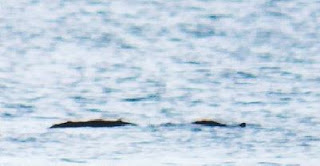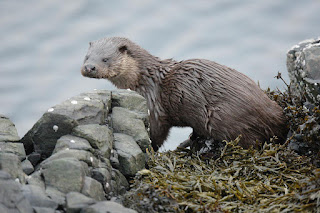On a summer afternoon when silence brooded over the hills, and the waters of Loch Chrois were motionless, two lovers sat on a sand-dune at the end of the loch. "sweet is the water out of the cup when stolen", says a proverb of the Gael, and sweet to the lovers was this time because none knew of their meeting, least of all their fathers and mothers, for between the two families was a great feud.
As they talked, the sun sank behind the mountain; still they sat side by side when the afterglow suffused
the western sky. The silence of a summer afternoon passed into the peace of a summer evening, and dark shadows gathered in the hollows around them ere the lovers bethought them of their homes. "The game 1 came out to snare is still on the wing," the youth said; "the kye are on their way to the homestead," was her answer.
As they spoke, their eyes lighted on a black horse which pastured beside the loch. Thinking that it belonged to the clachan whence they came, the lovers led it towards a boulder, and there sprang on its back. Hardly were they seated, than the horse headed lochwards, and when they tried to slip from his back, they found that an invisible power gripped them. Then they knew that their steed was the Each-uisge of Loch Chrois.
On the further side of the water, men and women were returning from Fuaran-Gearradh, the cool well, whose waters, blessed by a passing saint, cured sick folk of many diseases. To them the lovers shouted for help, but it was in vain, for already the kelpie had gained the edge of the loch. Louder than the cries of the unwilling riders, rose the wild neighing of the black horse, as with unwonted fierceness he reared and plunged into the loch.
On either side of him as he fought his way to the centre, vast clouds of vapour were seen to rise from the water; and the people fled affrighted at the weird sounds that broke the stillness, and the strange sight on the loch. The bodies of the lovers were never found, and in every clachan and strath for miles around it is held that the demon carried them to the loch-depths where he dwells, there to await the call of the pibroch on the day of days."
Source: The Scottish Review Vol.28 July-October 1896
Thus runs the tale of the Scottish Water Kelpie, or to be more precise, the Each Uisge or Water Horse. The telling of the tale takes on many forms across the ages encompassing all manner of scenarios, the vast bulk of which are now lost. The aforementioned Loch Chrois in Ross-shire is but one example.
But what was the purpose of such a story and to whom was it directed? If you read the anthropologists of the time and those sceptics who parrot their words today, we are told it is a story manufactured to warn vulnerable children away from the shores of dangerous waters where death by drowning may await.
A plausible theory, but an improbable one that does not reflect the narrative that was recorded by the same Victorian anthropologists before the arrival of science and industry wiped away the oral tradition of many generations.
To wit, the Water Horse was portrayed as a predator that cared not for the age of its victim and whose mere concern lay rather in whether warm blood flowed through their veins. So, adults and children are likewise victims. Moreover, the dangers of water seems not to be the moral of the tale as Sabbath breaking is also featured as a caution to the indolent and, as noted above, no cause at all as lovers merely enjoy each others' company.
Which brings me to the contradiction in these tales. Why would a creature which is most definitely portrayed as a creature of the deep waters always have a land based narrative? Indeed, sometimes it is nowhere near the loch as the Loch Ness Kelpie of the Warlock would patrol the dark roads of the Slochd Muichd, miles away from Loch Ness (near the modern A9 road).
If one was intent on warding children away from dangerous shorelines, why not present the Water Horse as a fearsome beast that lies just under the water waiting to drag away any unwitting child who foolishly wades into its waters? Indeed, even a monster that could break forth from the waters and gallop after its errant victims would suffice. But a Water Horse in a field or on a distant road? Just what exactly is the deterrent value there?
There is none in that respect and one is rather left wondering what small grit of truth initially arose to allow these pearls of folklore to form around it and eventually hide it from modern eyes? What was it these ancient people perceived in these creatures that warranted it spending more time on land in these stories than actually in its native waters?
My suggestion is that though these creatures were evidently seen in the waters of Loch Ness, they were seen on land as well and this created a greater impact on the people than if they stayed in the water. The psychology of this should be evident because if the creature stays in the loch, then the natives can feel more secure on land. Water Horses are only an issue if you go out on a boat or go for a swim.
But bring them into the natural territory of humans and the perceived threat level of the Each Uisge rises significantly. So, just as people over the 84 years of the Loch Ness Monster have logged a noticeable number of land sightings, one may conclude that people centuries back were seeing these creatures on land and this eventually weaved its way into the fabric of their folklore.
Now just as we today are also fascinated by these tales, we seek an explanation as to why they come ashore. We think of such things as food, breeding, basking or some other less obvious reason. The old Highlanders similarly sought an explanation and theirs was food. Now why they would suggest that may be purely down to the fact that they feared these unknown creatures and so defaulted to the worst possible outcome to deter people from approaching them.
One suspects it is more than certain the death of any person was attributed to such creatures across the hills and glens of Scotland, whether the beast was responsible for it or not. That would seem to suggest their deadly role in folklore was assured for generations to come.
The author can be contacted at lochnesskelpie@gmail.com












































































































